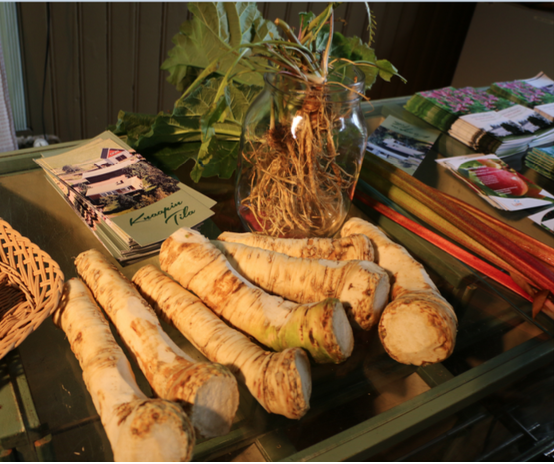Crop: Armoracia rusticana Gaertn. (Horseradish)
The landrace horseradish is cultivated in the municipality of Vehmaa in south eastern Finland (Finland Proper Region). According to the local parish register horseradish was brought to the municipal in 17th century by an armour-bearer of a career solder (a knight). It was taken to cultivation in gardens in the area. (Farmer interview 2019).
Today two farmers in Vehmaa cultivate it commercially since 1990s. The commercial horseradish cultivation in arable land differs significantly from growing it in garden. In May a part of some years old horseradish field is ploughed with a special one-ploughshare. The plough cuts horseradish roots and the most suitable ones, called side roots, are handpicked for new planting. Good root for planting is 1-1.5 cm thick and 20-30 cm long. The top of root is carved slanting before planting. Planting is performed manually setting roots to the bottom of furrow made by a planter.
Roots are manually digged up in summer with a special hoe, side roots are removed from the strongest root. Roots are planted to the field again to grow. Farmers call this method fattening horseradish. The first fattened horseradish roots are digged up at the end of September in order to get sufficiently roots to the market before the main crop. The harvest time continues until frost arrival in November and continues again in spring. (Farmer interview 2019.)
Cultivation System: conventional conditions.
Geographical Information
Country: Finland
‘Piparjuuri Vehmaa’ is traditionally cultivated in the municipality of Vehmaa in south eastern Finland (Finland Proper Region). Today two farmers cultivate it commercially in a few hectares area. In 2018, the leading farm had 3.5 ha of horseradish (earlier years 4.8 ha). Fields are located at 15 m a.s.l.
Farmer(s) description:
Commercial cultivation of horseradish needs much manpower. The area of 3.5 hectare produces 6,000-7,000 kilos and takes 2,000 working hours. Horseradish farmers have developed a cultivation method suitable for large scale farming. Availability of skilled labour force imported cheaper horseradish and wholesale business contracts has caused troubles to farmers. However, the stronger taste (higher content of glucosinalites) has proved to be a competitive edge over imported horseradish.
Propagation system: Clonal
Multiplication procedures and consequences on landrace diversity:Although horseradish flowers in early summer with white flowers it is vegetatively propagated since seed yield is very poor or absent. Notwithstanding horseradish vegetative multiplication in home gardens and in filed cultivation differs significantly, as described above, clones remain genetically stabile.
Management plan existence:‘Piparjuuri Vehmaa’ management relies on the economic value it provides to commercial farmers.
Added Values
‘Piparjuuri Vehmaa’ is commercially cultivated by two farmers who sell root crop to wholesale business to be sold as fresh in retail shops in Finland. ‘Piparjuuri Vehmaa’ covers over half of horseradish production in Finland (Finnish Food Authorities 2018). One farmer has developed a special seasonal product of horseradish sauce for local markets. The limited time and marketing resources restricts a large-scale product development. (Farmer interview 2019) The stronger taste (higher content of glucosinalites) has proved to be a competitive edge over imported horseradish.
Others (e.g. commercial/geographical brands or special traits):Its morphological (Suojala-Ahlfors 2014) and genetic (finger printing) characterisations have been carried out (Wedelsbäck Bladh et al 2014) and glucosinolates content has been evaluated (Wedelsbäck Bladh et al 2013) and compared to other Nordic horseradish clones.
Commercial farmers are not paid any extra support for cultivating ‘Piparjuuri Vehmaa’.
In 2002 the Finnish National Genetic Resources Programme accepted ‘Piparjuuri Vehmaa’ for long-term preservation at the central clonal collection located in Luke (GBK Luke Piikkiö, accession FIN67) (Sesto 2019). In 2019 the accession was accepted to the national backup preservation in the backup collection site for vegetables located in an open air museum operated by the Museum Centre of Turku in south eastern Finland.
If ‘Piparjuuri Vehmaa’ provides economic values for farmers also in future, it remains in cultivation and use. Farmers constantly seek more suitable horseradish clones for commercial cultivation; this may danger the continuity of its cultivation and use. Consumers lack knowledge on its added values as a landrace.
Accessions in the Finnish national clonal PGR collection are available for research and breeding under SMTA agreement. Uncertain for other use.
Case study provided by Natural Resource Institute (LUKE), Finland. Most of information were provided by Maarit Heinonen.
- EUROSTAT (2013) European Commission Statistics Database.
- Farmer interview (2019) Interview on 26th May 2019. Interview data is kept in Luke.
- Finnish Food Authority (2019) Statistics database.
- Sesto (2019) the NordGen PGR documentation system. URL: www.nordgen.org/sesto.
- Staughton J (2019) Organic Facts. 11 Impressive benefits of horseradish. https://www.organicfacts.net/health-benefits/vegetable/horseradish.html
- Suojala-Ahlfors T (2004) Description of the Finnish horseradish clones in 20014. Unpublished report,. MTT Argifood Research Finland, 7 p + appendix
- Wedelsbäck Bladh K (2014) Biodiversity in Nordic Horseradish. Doctoral Thesis Faculty of Landscape Planning, Horticulture and Agricultural Sciences. Swedish University of Agricultural Sciences. https://pub.epsilon.slu.se/11629/1/wedelsback_bladh_k_141105.pdf
- Wedelsbäck Bladh K, Olsson M K, Flemming Y (2013) Evaluation of glucosinolates in Nordic horseradish (Armoracia Rusticana). Botanica Lithuanica 19(1): 48-56
